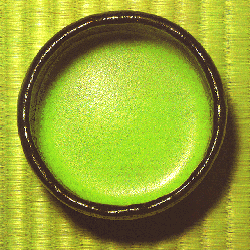SHIBUI SWORDS
LIBRARY
The first great master of tea, Sen-no-Rikyu, who lived about the time of Shakespeare, said that the art of the Japanese tea ceremony consisted of cleaning the tea room, arranging some flowers, making a nice little charcoal fire, and heating some water. One name for the tea ceremony, "cha-no-yu," means "hot water for tea." Naturally, there's a lot more to it than this. The tea room to be cleaned must be built and decorated to very specific standards; the flowers must be chosen and arranged in very prescribed ways (in fact, the art of flower arranging for tea ceremony, or "cha-bana," is an art in itself); the brazier in which the fire is built--indeed all the utensils used in a tea ceremony--must be chosen according to the time of the year, the purpose of the ceremony, the character of the guests invited; and so on and so on. Mastering even a small part of the numberless details of chanoyu can occupy a lifetime.
Like so many aspects of Japanese culture, the practice of drinking tea was brought from China at least a thousand years ago. The quasi-spiritual nature of tea drinking was present in China; Buddhist monks recommended tea as an aid to meditation and other religious practices. In Japan, however, tea (especially green tea) developed its own character, and the Japanese tea ceremony is a peculiarly Japanese phenomenon. The architecture, arts, crafts, and even religious practices of modern Japan owe a debt to chanoyu that is more extensive than even many Japanese themselves understand. The typical Japanese-style room (or "wa-shitsu"), with its straw mats and simple furnishings, was heavily influenced by the design of early tea rooms. Japanese arts and crafts from Chinese-style scroll painting and calligraphy to pottery, lacquerware, and cast iron came to maturity largely to serve the needs of the tea ceremony. The "modern" tea ceremony, dating to about 1600, developed alongside another peculiarly Japanese adaptation of a Chinese cultural idea: Zen. The tea ceremony was brought to a high art in Zen temples and in ordinary homes by Zen practioners, and today even the simplest and most secular tea ceremony still embraces the Zen aesthetic of simplicity, austerity, and devotion.
A brief moment of profound tranquility has been communally created and shared. It is an aesthetic moment, a work of art. It is a social moment, an opportunity to share basic human dignity and respect. It is a spiritual moment, a time and place to leave behind the noise and confusion of the everyday world to touch something eternal. It is a typically Japanese moment, fleeting and poignant with its own fragility.
Note on Care of
Books:
With books, one mar or fingerprint to the ink of the pictures -
one crease or crush to a page - any difference from brand-new, creates value
loss and permanently sets the book back. Just as chips in a blade - or chips in
the lacquer of a Saya create value loss. It is overt damage.
"Normal use" is
damage to books.
Anyone having reference or collector books, antique book
collectors or curators, all have the same, expected and specific method of
handling books. - This is similar to proper sword etiquette being the only
allowable method.
If you have any questions or wish to purchase any book,
please contact me at E-mail.
THE BOOK OF TEA by
Kakuzo Okakura, 1st edition 2005, $40.00. |
 |
THE JAPANESE TEA CEREMONY, 'CHA-NO-YU' by
A.L. Sadler, 1st edition, $20.00. |  |
THE STORY OF TEA, A Cultural History and Drinking Guide by
Mary Lou Heiss and Robert J. Heiss, $46.00. |  |
If you have any questions or wish to
purchase any book, please contact me at E-mail.

